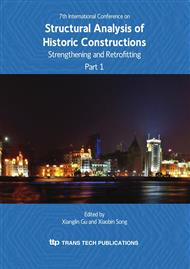p.801
p.807
p.815
p.821
p.831
p.837
p.843
p.849
p.855
Experimental and Computational Validation of Dissipative Prototype for the Seismic Protection of Heritage Buildings
Abstract:
Since earthquakes such as Northbridge (1994) and Kobe (1995) gave the impetuous for the development of performance-based design methods, engineers have been strenuously working to the improvement of the seismic behaviour of structures; in fact, high ductility frames, as well as damping and isolation systems, are nowadays common practice in seismic prone areas. Heritage buildings constitute an odd case: many historic centres are still considerably affected by seismic events (L’Aquila, 2009) due to the lack of a methodical retrofit and this, where applied, is still largely based on the increase of stiffness and capacity, without the due care for precious finishings. In order to address the lack of specific passive systems for heritage buildings, the authors have developed two typologies of dissipative devices that can be integrated in traditional steel anchors and installed within the masonry at the joints of perpendicular walls, where out-of-plane mechanisms are likely to form due to poor quality connections. Both prototypes, one based on the plasticity of steel, the other relying on friction, were tested as isolated elements in pseudo-static regime for proofing and fine tuning, and in a dynamic range typical of the seismic frequency content to validate the stability of dissipative loops. The paper focuses on pull-out tests aimed to analyse the behaviour of the hysteretic prototype in respect to traditional steel anchors in masonry panels with low shear capacity. Finite Element (FE) models were also developed and calibrated applying the data from tests. Experimental and computational results are discussed in the following; the need for further theoretical work concludes the paper.
Info:
Periodical:
Pages:
831-836
Citation:
Online since:
October 2010
Authors:
Price:
Сopyright:
© 2010 Trans Tech Publications Ltd. All Rights Reserved
Share:
Citation:


